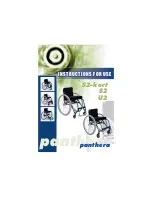
Instructions for use U2, S2, S2-short
Instructions for use U2, S2, S2-short
1
4
2
5
3
3
4
Adaptation
When adapting the chair to suit your sitting position and provide the mobility you
require, it is important that you make the following adjustments in the correct or-
der. First, adjust the sitting position and after that, adjust the balance of the chair
according to your mobility requirements. The sequence is important since when
you change your sitting position you also change the balance of the chair.
Consider that the effort you put into adapting your chair will provide long-term be-
nefi ts later on. Try out different adaptations for a few days to make sure you really
have found the best sitting posture and balance of the chair.
You should make the following adjustments
in this order:
1) The tension of the seat upholstery
2) The height of the footrest
3) The tension of the calf band
4) The angle of the backrest
5) The tension of the backrest upholstery
6) The balance of the wheelchair
7) The position of the brakes
1) Tension of the seat upholstery
The rear section of the seat upholstery can be tightened
or loosened by adjusting the Velcro band underneath the
seat as shown in fi gure 2. This allows you to vary your
sitting height by about 2 cm up or down.
Figure 2.
Band for tightening
seat upholstery.
Figure 3.
Screw for the
footrest.
2) Height of the footrest
The footrest can be adjusted up or down. Remove the
two screws supporting the footrest on the front of the
frame as shown in fi gure 3, unscrew using a 3 mm
socket head key. Push the end plug down by placing key
19 around the tubing above and tapping down with a
hammer. You will then be able to move the footrest up
or down to fi t into one of the fi ve alternative height po-
sitions. You should adjust the footrest at a height where
your thighs are supported by the seat at the same time as
your feet are supported by the footrest.
Figure 5.
Back locking func-
tion.
Figure 4.
Calf band.
3) Tension of the calf band
The tension of the calf band, se fi gure 4, can be
adjusted and will affect how far forward you
place your feet on the footrest. The appropriate
tension depends largely on how long or short
your legs are.
4) Angle of the backrest
The angle of the backrest can be adjusted by fi rst twisting the backrest lock ec-
centric out of the way so that the lock does not get in your way, and then adjusting
the screws to adjust the angle.
Do as follows, see fi gure 5:
Dismantle the back locking function by pulling the wire (1) and folding the
backrest forward.
Loosen the lock screws (2) and unscrew them a few rotations using socket head
key no. 5.
Twist the backrest lock eccentrics (3) downwards so that the lock faucet does
not fi x the backrest in place. Use cap key no. 19. Do this on both sides.
1.
2.
3.
Then adjust the angle of the backrest by fi rst
loosening the lock nuts (4) using cap key no.
13, and then screw the adjustment screws in or
out (5) using the 5 mm socket head key. If you
unscrew the adjustment screws the backrest will
tilt forward. If you tighten the adjustment screws
the backrest will tilt backwards. It is important
to adjust both sides equally to avoid the backrest
tubing becoming crooked. Test this by putting
the backrest in upright position and checking
that both adjustment screws are touching the
frame. Try out suitable backrest angles and tigh-
ten the lock nuts once you are satisfi ed.
To reengage the back locking function pull
the backrest into upright position and twist the
backrest lock eccentrics so that the lock faucets
spring out into their tracks. Then tighten the
lock screws. Do this on both sides.
4.
5.



























